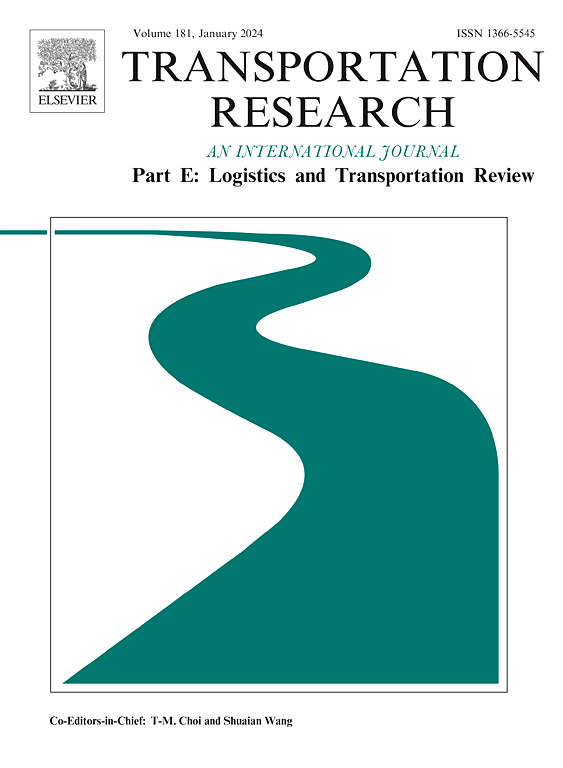配额制中最小化价格波动的分布式稳健优化
IF 8.3
1区 工程技术
Q1 ECONOMICS
Transportation Research Part E-Logistics and Transportation Review
Pub Date : 2024-10-30
DOI:10.1016/j.tre.2024.103812
引用次数: 0
摘要
配额制度在调节公益产品和控制负外部性方面发挥着至关重要的作用,其主要重点是社会影响而非经济效益。本文研究了配额发放的决策过程,旨在控制增长率并确保价格长期稳定。我们首先提出了配额制度的机会约束问题,并使用样本平均近似法进行求解。由于计算需求,我们还探索了其他近似方法。我们考虑了两类配额制:已知分布的成熟配额制和分布不明确的新配额制。对于成熟系统,使用条件风险值(CVaR)来近似机会约束;对于新建立的系统,在稳健优化框架内使用最坏情况 CVaR,并推导出二进制搜索算法来高效解决问题。通过使用新加坡车辆配额系统的数据进行计算研究,验证了建议模型的有效性。在已知分布的情况下,我们的 CVaR 样本平均近似(CVaR-SAA)模型优于传统模型,违规概率降低了 56.32% 以上。在分布不明确的情况下,最坏情况 CVaR 近似稳健优化(WCVaR-RO)模型提供了出色的解决方案,尤其是在最大违规概率(MVP)方面。在最显著的情况下,WCVaR-RO 将 MVP 降低了 53.37% 以上。这项研究为配额系统的管理提供了宝贵的见解。本文章由计算机程序翻译,如有差异,请以英文原文为准。
Distributionally robust optimization for minimizing price fluctuations in quota system
Quota systems play a crucial role in regulating public-interest goods and controlling negative externalities, with a primary focus on social impacts rather than economic benefits. This paper examines the decision-making process for quota release, aiming to control growth rates and ensure price stability over time. We first develop a chance-constrained problem for quota systems, solving it using sample average approximation. Due to computational demands, alternative approximation methods are explored. We consider two types of quota systems: mature systems with known distributions and newly established systems with distributional ambiguity. For mature systems, Conditional Value-at-Risk (CVaR) is used to approximate the chance constraint, while for newly established systems, worst-case CVaR is employed within a robust optimization framework and the binary search algorithm is derived to efficiently solve the problem. The proposed models’ effectiveness is validated through computational studies using data from Singapore’s Vehicle Quota System. With known distributions, our CVaR sample average approximation (CVaR-SAA) model outperforms traditional models, reducing violation probability by more than 56.32%. With distributional ambiguity, worst-case CVaR approximation robust optimization (WCVaR-RO) model provides superior solutions, particularly in maximum violation probability (MVP). In the most notable case, WCVaR-RO reduces the MVP by over 53.37%. This research offers valuable insights into the management of quota systems.
求助全文
通过发布文献求助,成功后即可免费获取论文全文。
去求助
来源期刊
CiteScore
16.20
自引率
16.00%
发文量
285
审稿时长
62 days
期刊介绍:
Transportation Research Part E: Logistics and Transportation Review is a reputable journal that publishes high-quality articles covering a wide range of topics in the field of logistics and transportation research. The journal welcomes submissions on various subjects, including transport economics, transport infrastructure and investment appraisal, evaluation of public policies related to transportation, empirical and analytical studies of logistics management practices and performance, logistics and operations models, and logistics and supply chain management.
Part E aims to provide informative and well-researched articles that contribute to the understanding and advancement of the field. The content of the journal is complementary to other prestigious journals in transportation research, such as Transportation Research Part A: Policy and Practice, Part B: Methodological, Part C: Emerging Technologies, Part D: Transport and Environment, and Part F: Traffic Psychology and Behaviour. Together, these journals form a comprehensive and cohesive reference for current research in transportation science.

 求助内容:
求助内容: 应助结果提醒方式:
应助结果提醒方式:


